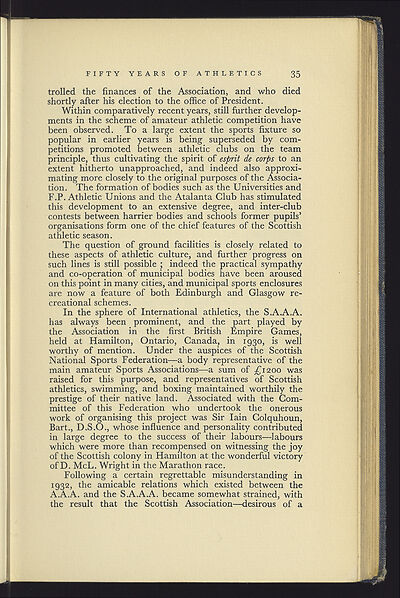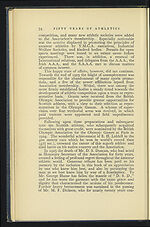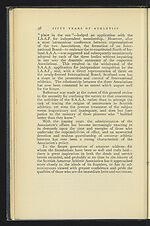Download files
Complete book:
Individual page:
Thumbnail gallery: Grid view | List view

FIFTY YEARS OF ATHLETICS
35
trolled the finances of the Association, and who died
shortly after his election to the office of President.
Within comparatively recent years, still further develop-
ments in the scheme of amateur athletic competition have
been observed. To a large extent the sports fixture so
popular in earlier years is being superseded by com-
petitions promoted between athletic clubs on the team
principle, thus cultivating the spirit of
esprit de corps
to an
extent hitherto unapproached, and indeed also approxi-
mating more closely to the original purposes of the Associa-
tion. The formation of bodies such as the Universities and
F.P. Athletic Unions and the Atalanta Club has stimulated
this development to an extensive degree, and inter-club
contests between harrier bodies and schools former pupils'
organisations form one of the chief features of the Scottish
athletic season.
The question of ground facilities is closely related to
these aspects of athletic culture, and further progress on
such lines is still possible ; indeed the practical sympathy
and co-operation of municipal bodies have been aroused
on this point in many cities, and municipal sports enclosures
are now a feature of both Edinburgh and Glasgow re-
creational schemes.
In the sphere of International athletics, the S.A.A.A.
has always been prominent, and the part played by
the Association in the first British Empire Games,
held at Hamilton, Ontario, Canada, in 1930, is well
worthy of mention. Under the auspices of the Scottish
National Sports Federation—a body representative of the
main amateur Sports Associations—a SUM Of �Cl2OO was
raised for this purpose, and representatives of Scottish
athletics, swimming, and boxing maintained worthily the
prestige of their native land. Associated with the Com-
mittee of this Federation who undertook the onerous
work of organising this project was Sir Iain Colquhoun,
Bart., D.S.O., whose influence and personality contributed
in large degree to the success of their labours—labours
which were more than recompensed on witnessing the joy
of the Scottish colony in Hamilton at the wonderful victory
of D. McL. Wright in the Marathon race.
Following a certain regrettable misunderstanding in
1932, the amicable relations which existed between the
A.A.A. and the S.A.A.A. became somewhat strained, with
the result that the Scottish Association—desirous of a
t
35
trolled the finances of the Association, and who died
shortly after his election to the office of President.
Within comparatively recent years, still further develop-
ments in the scheme of amateur athletic competition have
been observed. To a large extent the sports fixture so
popular in earlier years is being superseded by com-
petitions promoted between athletic clubs on the team
principle, thus cultivating the spirit of
esprit de corps
to an
extent hitherto unapproached, and indeed also approxi-
mating more closely to the original purposes of the Associa-
tion. The formation of bodies such as the Universities and
F.P. Athletic Unions and the Atalanta Club has stimulated
this development to an extensive degree, and inter-club
contests between harrier bodies and schools former pupils'
organisations form one of the chief features of the Scottish
athletic season.
The question of ground facilities is closely related to
these aspects of athletic culture, and further progress on
such lines is still possible ; indeed the practical sympathy
and co-operation of municipal bodies have been aroused
on this point in many cities, and municipal sports enclosures
are now a feature of both Edinburgh and Glasgow re-
creational schemes.
In the sphere of International athletics, the S.A.A.A.
has always been prominent, and the part played by
the Association in the first British Empire Games,
held at Hamilton, Ontario, Canada, in 1930, is well
worthy of mention. Under the auspices of the Scottish
National Sports Federation—a body representative of the
main amateur Sports Associations—a SUM Of �Cl2OO was
raised for this purpose, and representatives of Scottish
athletics, swimming, and boxing maintained worthily the
prestige of their native land. Associated with the Com-
mittee of this Federation who undertook the onerous
work of organising this project was Sir Iain Colquhoun,
Bart., D.S.O., whose influence and personality contributed
in large degree to the success of their labours—labours
which were more than recompensed on witnessing the joy
of the Scottish colony in Hamilton at the wonderful victory
of D. McL. Wright in the Marathon race.
Following a certain regrettable misunderstanding in
1932, the amicable relations which existed between the
A.A.A. and the S.A.A.A. became somewhat strained, with
the result that the Scottish Association—desirous of a
t
Set display mode to:
![]() Universal Viewer |
Universal Viewer | ![]() Mirador |
Large image | Transcription
Mirador |
Large image | Transcription
Images and transcriptions on this page, including medium image downloads, may be used under the Creative Commons Attribution 4.0 International Licence unless otherwise stated. ![]()
| Sports publications > Fifty years of athletics > (45) |
|---|
| Permanent URL | https://digital.nls.uk/231656648 |
|---|
| Description | More than 230 sports publications from the National Library of Scotland's collections. Featured sports include football, rugby, golf, shinty, athletics, bowls, cricket and hockey. Among the material from the late 19th and early 20th centuries are match programmes, club histories, and handbooks. From the late 20th century are promotional materials to encourage greater diversity in sport. Most items cover sports activities in Scotland. There are also publications relating to the Olympics and international matches. |
|---|---|
| Additional NLS resources: |
|

